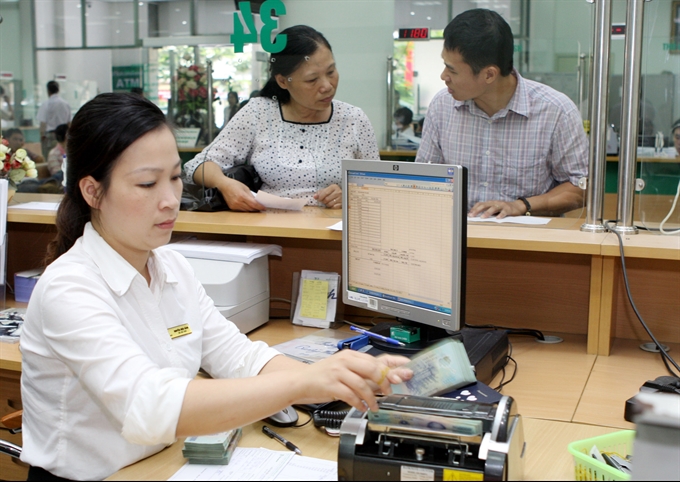 Economy
Economy

Intensifying the scale and health of the financial market should be one of the top priorities for Việt Nam in its ongoing economic restructuring process.
 |
| Trading activities at Vietcombank’s head office. The current size of the local financial market does not meet the demand of economic development. – VNA/VNS Photo Trần Việt |
HÀ NỘI (VNS) — Intensifying the scale and health of the financial market should be one of the top priorities for Việt Nam in its ongoing economic restructuring process, a finance official said.
Vũ Viết Ngoạn, Chairman of the National Financial Supervisory Commission (NFSC) told a seminar in Hà Nội yesterday, as the commission launched a financial market overview report for 2015, that this market will especially play an important role in the country’s economic development between now and 2035.
The Ministry of Planning and Investment estimated that the domestic economy will need a total investment capital of around VNĐ10 quadrillion (US$444.5 billion) for its growth over the next five years.
Ngoạn said that the current size of the local financial market is modest compared to global and regional ones, and it is yet to meet the demand of economic development, especially when Việt Nam is integrating faster into the global economy.
Last year, financing channels including bank credits and share and bond issuances supplied a combined nearly VNĐ800 trillion ($35.6 billion), or some 19 per cent of the country’s gross domestic product (GDP), for the domestic economy, according to the report.
“It is hard to manage adequate capital for the economy, and even harder to distribute capital resources effectively,” Ngoạn said.
Việt Nam currently pursues three fundamental economic goals, including stabilising the macro-economy, maintaining reasonable growth and speeding up economic reforms.
“This year and a few years ahead, if Việt Nam does not accelerate reforms… creating a healthy financial market, renewing growth models and making big changes in labour productivity and economic competitiveness, it will be hard for the country to achieve three basic targets in its socio-economic development plans,” he said.
Ngoạn said Việt Nam’s economic restructuring process, which has been underway for four years, has helped curb massive investments and stepped up progress of the business equitisation process.
This has contributed to the country’s economic achievements last year, when its GDP growth rate reached 6.67 per cent and inflation was controlled at 0.63 per cent, while the global economy continued to face significant headwinds.
However, officials said the national economy still faces many challenges.
NFSC Vice Chairman Trương Văn Phước said that, while foreign direct investment enterprises are still a major force driving the country’s growth, a slow State-run enterprise rationalisation process remains an obstacle for the development of the domestic stock market, which is still witnessing decline.
Phước said the domestic credit institution system sees prospects this year, with the quality of lending significantly improving last year. Bad debts totalled nearly VNĐ120 trillion ($5.3 billion), equivalent to 2.9 per cent of the total outstanding loans in the system in 2015. This ratio was 3.7 per cent in 2014.
However, he pointed out that the banking system sees potential risks related to liquidity, when medium to long-term loans grew over 55 per cent while the capital mobilised for medium to long-term use rose by roughly 10 per cent last year.
Ngoạn said the sharply declining oil prices are hitting national budget revenues, and rapidly growing public debt is challenging policymakers who are making efforts to balance macro-economic conditions.
Trần Đình Thiên, director of the Việt Nam Institute of Economics, under the Việt Nam Academy of Social Sciences, said the economy looks worrying as official data revealed that State budget overspending reached around 5 per cent of the country’s GDP, and public debt neared a security cap of 65 per cent of GDP last year.
The Ministry of Finance reported the national budget overspending of VNĐ25.5 trillion ($1.1 billion) in the first two months of this year alone, representing 10.6 per cent of the annual quota. Budget revenue reached VNĐ160 trillion while budget spending hit VNĐ185.6 trillion in two months.
A government’s report said by 2015 Việt Nam’s public debt stood at VNĐ2.7 quadrillion ($121 billion) against the figure of VNĐ1.3 quadrillion ($58.3 billion) in 2011. This means, on average, the public debt has increased by about 20 per cent a year.
“What worries me the most is that our public debt is much bigger than our capacity to repay it. Our current revenue collection cannot cover our regular spending and pay back the debt,” Nguyễn Quang Thái, vice chairman of the Việt Nam Union of Economic Science, said.
“Just paying the debt alone would eat up more than 25 per cent of our annual national budget collection. It is projected that in the two years 2019 and 2020 that figure will rise to 30 per cent,” he told the Tuổi trẻ (Youth) newspaper recently. — VNS




